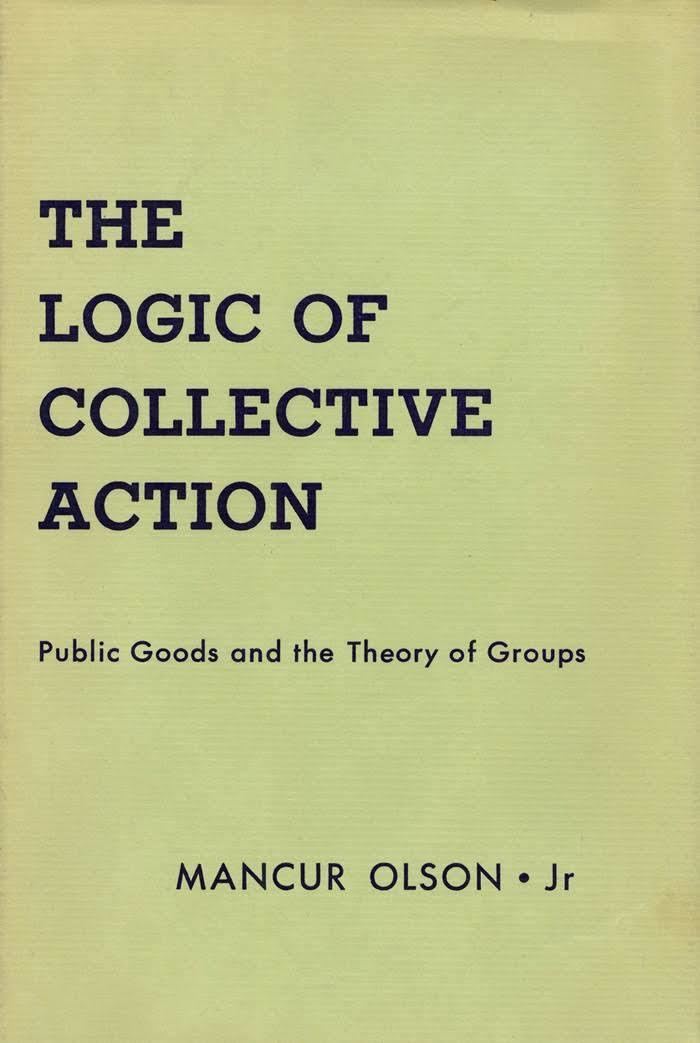Originally published 1965 | ||
 | ||
Similar Mancur Olson books, Sociology books | ||
The Logic of Collective Action: Public Goods and the Theory of Groups is a book by Mancur Olson, Jr. published in 1965. It develops a theory of political science and economics of concentrated benefits versus diffuse costs. Its central argument is that concentrated minor interests will be overrepresented and diffuse majority interests trumped, due to a free-rider problem that is stronger when a group becomes larger.
Contents
Overview
The book challenged accepted wisdom in Olson’s day that:
- if everyone in a group (of any size) has interests in common, then they will act collectively to achieve them; and
- in a democracy, the greatest concern is that the majority will tyrannize and exploit the minority.
The book argues instead that individuals in any group attempting collective action will have incentives to "free ride" on the efforts of others if the group is working to provide public goods. Individuals will not “free ride” in groups that provide benefits only to active participants.
Pure public goods are goods that are non-excludable (i.e. one person cannot reasonably prevent another from consuming the good) and non-rivalrous (one person’s consumption of the good does not affect another’s, nor vice versa). Hence, without selective incentives to motivate participation, collective action is unlikely to occur even when large groups of people with common interests exist.
The book noted that large groups will face relatively high costs when attempting to organize for collective action while small groups will face relatively low costs, and individuals in large groups will gain less per capita of successful collective action. Hence, in the absence of selective incentives, the incentive for group action diminishes as group size increases, so that large groups are less able to act in their common interest than small ones.
The book concludes that, not only is collective action by large groups difficult to achieve even when they have interests in common, but situations could occur where the minority (bound together by concentrated selective incentives) can dominate the majority.
Critique
Olson's original logic of collective action has received several critiques, based either on a different interpretation of the observations on minority interest representation, or on a disagreement on the degree of concentrated interest representation.
Information asymmetry
Susanne Lohmann agrees with puzzling observations made by Olson, which she classifies as economic and political puzzles. Economic puzzles, for instance, are measures that result in a general welfare loss in favour of minority protection, many times larger than the minority benefit. One example she gives relates to a quota on sugar imports in the United States, which is calculated to generate 2261 jobs at the expense of a general welfare reduction of $1,162 million (Hufbauer and Elliot, 1994). The implicit price for a job in the sugar industry is then above $500,000, allowing for significant room for Pareto improvement. Political puzzles relates to cases where minority trumps majority. An example she gives is the so-called rural bias in urbanized and developed countries, of which the Common Agricultural Policy in the European Union is a prime example.
Lohmann observes that Olson's free-rider problem is insufficient to explain these puzzles. She sees the explanation in the role of uncertainty (information asymmetry among voters) when special interest groups or individuals evaluate how political actors promote their interests. She states that everyone can be considered a special interest. Because everyone is (relatively) sure how well their interests are represented, they account for more weight to their interest representation when evaluating political actors than to the general benefit. Lohmann argues that it could be politically viable to focus on separate narrow interests at the expense of general benefits.
Legitimacy
Gunnar Trumbull rejects the observation by Olson and Lohmann that concentrated interests dominate public policy. Historically, he points out, diffuse interests nearly always found ways to be represented in public policy making, for instance by relating to retirees, patients or consumers. Trumbull says that the explanation for this lies with the role of legitimacy when interest groups promote policies. He argues that diffuse interests have a legitimacy premium when they manage to mobilize, while concentrated interests are viewed with suspicion. He describes the concept of legitimacy coalitions, which are coalitions between state policymakers, social activists or industry to support the promotion of certain policy. By having to form a coalition, the interests are more broadly represented. The post-war neocorporatist system is an example of such a coalition.
Critical Mass
Marwell and Oliver use mathematical and computational models to show that a number of the assumptions made by Olson are not only unrealistic, but if they are relaxed, then the behavior of a system of rational agents changes dramatically. One is that the "production function" of goods is linear. If this function accelerates, for example, then a critical mass of early contributors can encourage a large number of others to contribute. Another assumption is that the cost of the good is a function of the size of the group that would benefit from it. For many public goods, this is not true, and Marwell and Oliver show that when the interest group is larger, there is a larger chance that it will include someone for whom it is rational to provide the good, either in part or in full.
